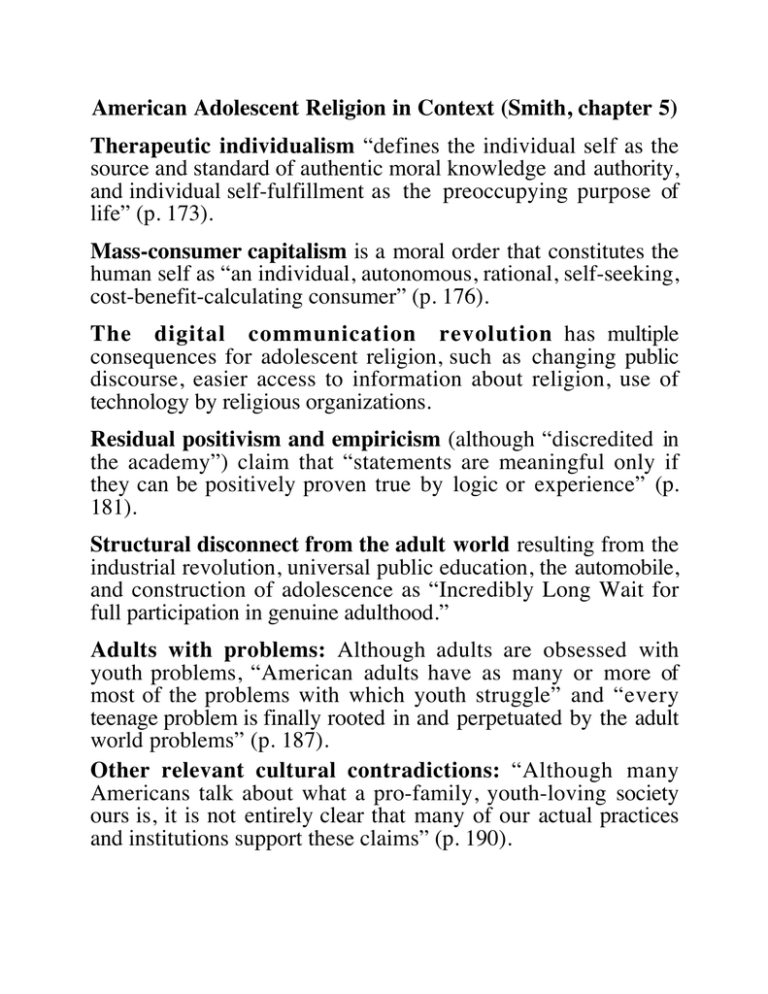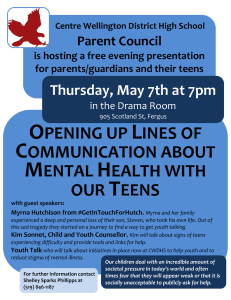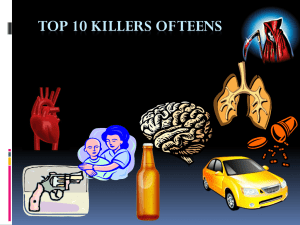
American Adolescent Religion in Context (Smith, chapter 5)
Therapeutic individualism “defines the individual self as the
source and standard of authentic moral knowledge and authority,
and individual self-fulfillment as the preoccupying purpose of
life” (p. 173).
Mass-consumer capitalism is a moral order that constitutes the
human self as “an individual, autonomous, rational, self-seeking,
cost-benefit-calculating consumer” (p. 176).
The digital communication revolution has multiple
consequences for adolescent religion, such as changing public
discourse, easier access to information about religion, use of
technology by religious organizations.
Residual positivism and empiricism (although “discredited in
the academy”) claim that “statements are meaningful only if
they can be positively proven true by logic or experience” (p.
181).
Structural disconnect from the adult world resulting from the
industrial revolution, universal public education, the automobile,
and construction of adolescence as “Incredibly Long Wait for
full participation in genuine adulthood.”
Adults with problems: Although adults are obsessed with
youth problems, “American adults have as many or more of
most of the problems with which youth struggle” and “every
teenage problem is finally rooted in and perpetuated by the adult
world problems” (p. 187).
Other relevant cultural contradictions: “Although many
Americans talk about what a pro-family, youth-loving society
ours is, it is not entirely clear that many of our actual practices
and institutions support these claims” (p. 190).
Adolescent Religion and Life Outcomes
Religion has positive effects on American adolescents: “[A]lthough
many teens cannot see it or are not able to articulate it,… the differences
between more religious and less religious teenagers in the United States
are actually significant and consistent across every outcome measure
examined: risk behaviors, quality of family and adult relationships, moral
reasoning and behavior, community participation, sexual activity, and
emotional well-being.”
Risk behaviors: More religious teens are less likely to smoke, drink,
smoke marijuana, cut class, get poor grades, get suspended and expelled,
and be rebellious/have bad temper (according to parents).
Sexual belief and activity: More religious teens are less likely to have
engaged in various sexual activities, less likely to believe that “it is okay
for teens to have sex if they are emotionally ready for sex,” and more
likely to believe in waiting for marriage to have sex.
Emotional well-being: More religious teens are more likely to have a
positive body-image, feel cared for by people responsible for them, think
and plan about the future, and think about the meaning of life, and less
likely to feel sad or depressed, or alone and misunderstood.
Adult ties and quality of family relationships: More religious teens are
more likely to be comfortable talking to adults other than parents or
relatives, less likely to be unsupervised during afternoons or evenings, and
have a higher average number of adults to turn to for support, advice and
help. More religious teens are more likely to have positive relationships
with their parents and siblings.
Moral reasoning, honesty and compassion: More religious teens are
less likely to believe that “morals are relative, that there are no definite
rights and wrongs for everybody,” lie to parents and do things “they
hoped their parents would never find out about.” They are more likely to
care about the needs of the poor and elderly in the United States and about
racial equality and more likely to do volunteer work.
Reasons for religion’s influences: provides (1) moral order (moral
directives, spiritual experiences & role models), (2) learned competencies
(community & leadership skills, coping skills, cultural capital) and (3)
social and organizational ties (social capital, network closure,
extracommunity links).





